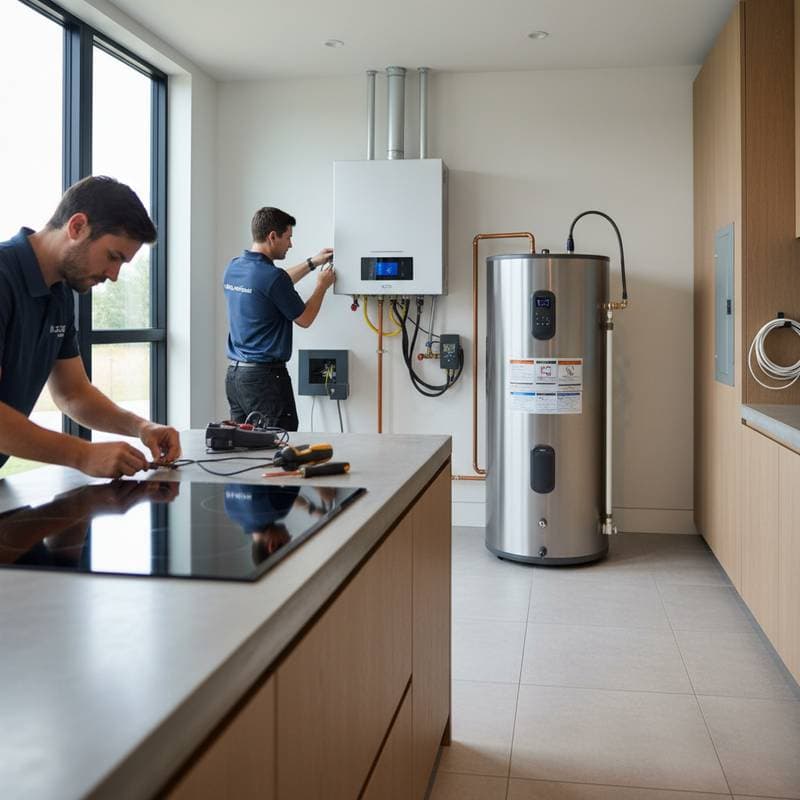Introduction to Home Electrification
Home electrification represents a shift from fossil fuel dependence to efficient electric alternatives. This transition targets gas-powered systems in heating, cooking, and water heating. In 2025, such changes promise substantial reductions in energy costs and environmental impact.
Many households rely on gas for daily needs, yet electric options now outperform them in efficiency and reliability. The potential to cut gas usage by 60% arises from modern technologies that use less energy overall. Readers gain practical insights here to evaluate and implement these upgrades.
Benefits of Switching to Electric Systems
Electrification lowers utility bills through superior energy efficiency. Heat pumps, for instance, transfer heat rather than generate it, achieving up to three times the efficiency of gas furnaces. This results in significant savings, often 50% or more on heating costs alone.
Comfort improves with consistent temperatures and quieter operation. Electric systems eliminate combustion byproducts, enhancing indoor air quality and reducing health risks from pollutants. Additionally, homes become more resilient during power outages with backup options like solar integration.
Environmental advantages include reduced greenhouse gas emissions. By aligning with renewable electricity sources, electrification supports a cleaner planet. Long-term, these changes future-proof homes against rising gas prices and regulatory shifts.
Key Upgrades for Gas Bill Reduction
Heat Pumps for Heating and Cooling
Heat pumps serve as all-electric solutions for both heating and cooling. They extract warmth from outdoor air even in cold climates, maintaining efficiency down to low temperatures. Installation typically costs between $4,000 and $8,000, but performance exceeds traditional systems.
Select models with high SEER ratings for optimal savings. Pair them with smart thermostats to adjust settings automatically based on occupancy. This upgrade alone can eliminate gas heating needs, contributing heavily to the 60% reduction goal.
Induction Cooktops for Efficient Cooking
Induction cooktops heat pots directly using electromagnetic fields, wasting minimal energy. They boil water faster than gas stoves and offer precise temperature control. Safety features prevent burns, as surfaces remain cool to the touch.
These units install in standard kitchen cutouts, with prices starting at $1,000 for basic models. Energy use drops by up to 10% compared to gas, and cleanup proves simpler without residue from open flames. Transitioning here reduces gas dependency in meal preparation.
Electric Water Heaters and Tankless Options
Electric water heaters, especially heat pump varieties, provide hot water with 200% to 300% efficiency over gas models. Tankless versions heat water on demand, avoiding standby losses. Capacities suit various household sizes, from 40 gallons for small families to larger units.
Installation involves electrical upgrades, often costing $1,500 to $3,000. These systems deliver endless hot water without the fluctuations common in gas setups. Overall, they cut water heating expenses, which account for 15% to 20% of home energy use.
Navigating Rebates and Incentives
Federal programs like the Inflation Reduction Act offer rebates up to $2,000 for heat pumps and $1,400 for electric water heaters. State and utility incentives vary, potentially covering 30% to 50% of costs. Check eligibility through energy.gov or local providers.
Combine these with tax credits for solar panels to offset electricity needs. Professional audits identify the best rebate matches for specific homes. Planning around these financial aids makes electrification affordable and accelerates payback periods to three to five years.
Steps to Electrify Your Home
-
Assess current systems: Review gas usage via utility bills and inspect appliances for age and efficiency.
-
Conduct an energy audit: Hire a certified professional to pinpoint high-consumption areas and recommend electric alternatives.
-
Upgrade electrical infrastructure: Ensure panels support increased loads, possibly adding a subpanel for $500 to $2,000.
-
Select and install equipment: Choose ENERGY STAR-rated products and work with licensed contractors for compliance.
-
Integrate renewables: Add solar panels if feasible to maximize savings and independence from the grid.
-
Monitor and optimize: Use apps to track energy use post-installation and adjust for peak efficiency.
Follow these steps methodically to achieve the targeted 60% gas reduction. Start small with one upgrade to build momentum.
Realizing Savings and Sustainability
Electrification transforms homes into efficient, comfortable spaces. Annual gas bill savings of $500 to $1,000 become common, depending on location and usage. Healthier air and reduced emissions contribute to personal and planetary well-being.
As 2025 approaches, these upgrades position households for energy independence. Consult experts early to tailor plans. The result is a home that operates smarter, costs less, and supports a sustainable future.










